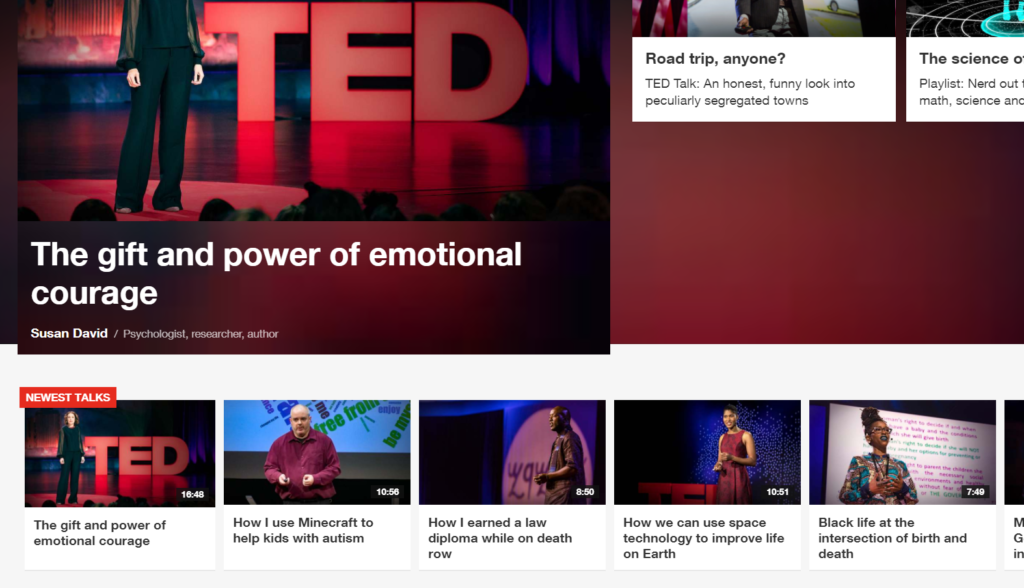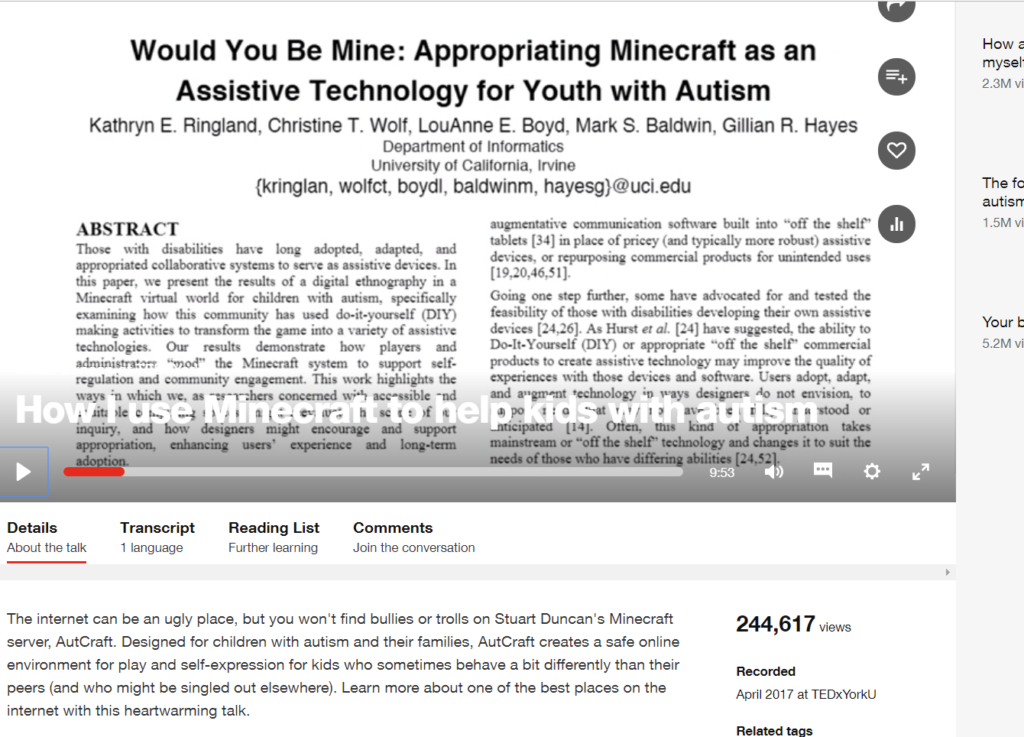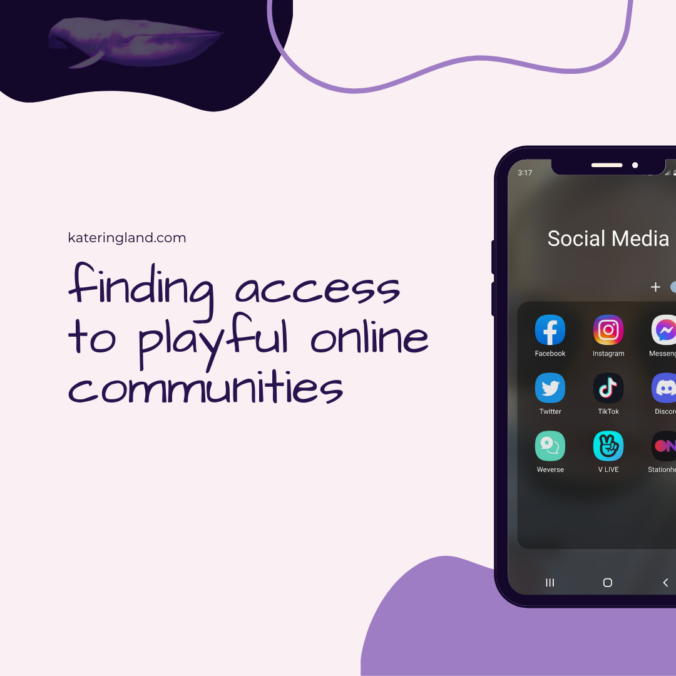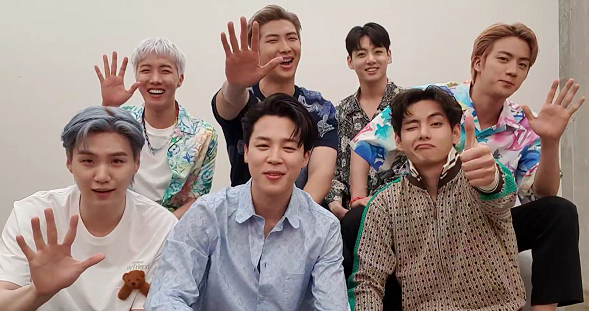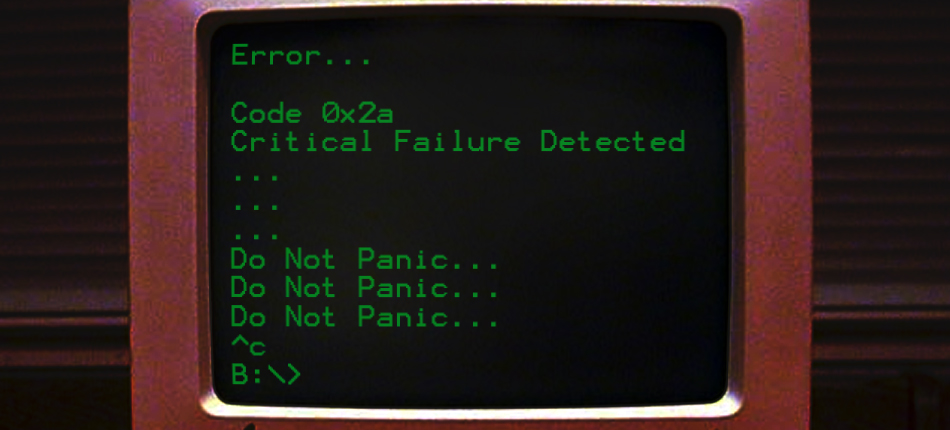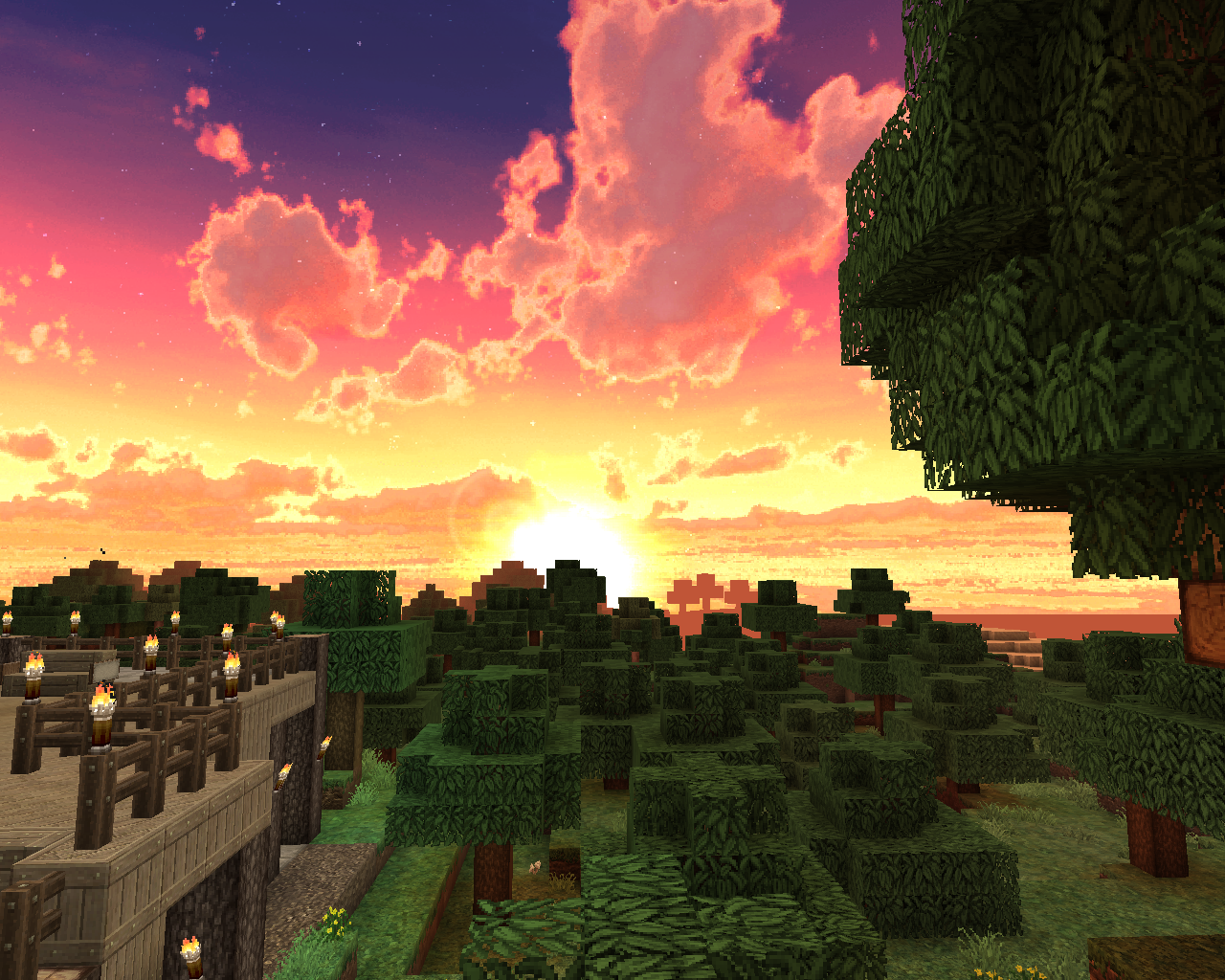Check out the episode through your favorite listening platform here: https://spotifyanchor-web.app.link/e/g5SeBAqe3Eb
Tag: research papers (Page 1 of 5)
Understanding the Collaborative Construction of Playful Places in Online Communities
By: Kathryn E. Ringland, Arpita Bhattacharya, Kevin Weatherwax, Tessa Eagle, and Christine T. Wolf
[This article was written by Kate with the help and support of her co-authors.]
This work is cross-posted on Medium: https://kateringland.medium.com/armys-magic-shop-668cb8a3c0c0
Preview: Using ethnographic fieldwork, we dive into the world of BTS and ARMY’s Magic Shop. The Magic Shop is a conceptual place for community members to relax, connect, and support one another. The Magic Shop is built on a foundation of play and exists in all the spaces that the BTS ARMY community lives and plays. This research helps us understand the deep importance of the BTS ARMY Magic Shop to community members and how we can create better and safer platforms for the community in the future.
This work will be appearing at CHI 2022. The preprint can be found at https://bit.ly/MagicShopCHI2022

Introduction
When we think about researching play, we often think of studying play in children, designing educational games, or using games to improve health. In this work, we’ve taken research on play in an understudied direction by looking at adults engaging in play for their leisure or as a hobby. In particular, we are looking at spaces not intentionally designed for play — that is, technologically mediated social spaces that are repurposed as socially playful places. For example, we are looking at social media platforms instead of multiplayer games where the play is scaffolded into the platform. This research is vital for better understanding how communities at play use technology. Outcomes of this work will ultimately help designers and researchers build better supportive and safer platforms for communities in the future.
Specifically, we turned our attention to the musicians BTS and their fandom, ARMY. We look at ARMY because of the community’s reach and diversity. Composed of a diverse but often underrepresented majority, ARMY is also a largely misunderstood community as it experiences biases, stereotyping, and oppressions that intersect across the different identities and interests of people in this fandom. We hope this work helps to reverse some of the stigma around ARMY and fandoms as a whole.
The goal of this work is to illustrate how BTS and ARMY work together to create a socially playful place in-person and online, built upon what the artists and community members call the “Magic Shop.” The foundations of this Magic Shop are people and their shared values, transcending the physical space to online and emotional or abstract places.
BTS & ARMY
BTS (방탄소년단 or Bangtan Soyeondan) is a group of seven musicians from South Korea who debuted in 2013. Their fandom, ARMY, has been growing globally since the band’s inception. ARMY, as a community, uses a variety of social media platforms to communicate such as Twitter, Instagram, TikTok, Facebook, and Weverse. ARMY has a flat, non-hierarchical and participatory power structure [6]. That is, there is no clear “leader” of ARMY, other than, perhaps, the BTS members who also consistently share their power and success with ARMY.
ARMY has been stigmatized in the media for a number of reasons, including its majority fem-identifying membership and its supposed “bot-like” behavior [7]. However, as this work and others have shown, this is far from reality. ARMY is a large, diverse fandom with many different contexts, experiences, and values, and cannot be described in singularity [1]. ARMY is perhaps best known for their organizing and activism, such as raising donations for causes like Black Lives Matter in short periods of time.
Welcome to the Magic Shop: Research Methods
In this study, we report the findings from an ongoing online ethnographic study of the ARMY community. Data were collected through ARMY’s public social media posts on Twitter and TikTok, as well as through publicly available media posted by BTS on social media platforms including TikTok, Twitter, Weverse, YouTube, and VLIVE (this portion of the study was conducted before the members of BTS opened their individual Instagram accounts in December 2021).

I was responsible for all data collection and primary data analysis, identifies as an ARMY and has been on ARMY TikTok since September 2020 and ARMY Twitter since January 2021. For more details about data collection and analysis, please refer to the full paper.
Important Research Considerations: Keeping BTS & ARMY Safe
Safety of BTS and ARMY are the priority in conducting this research. This work is exempt from ethics board approval because it involves ethnographic observations of public social media data. However, I and my co-authors took extra care while collecting, analyzing, and presenting this data.
As a member of the ARMY community, I take responsibility for protecting individuals who may interact with my various social media accounts. The BTS ARMY community has a history of being marginalized, including incidents of racism, xenophobia, and ageism. Further BTS ARMY faces more criticism among media and other outsiders [2,4,5]. ARMY has a fraught history of outsiders seeking to cause harm or use ARMY and BTS for their own profit or agenda [8,9].

The epistemic violence [11] enacted upon the community has left many with little trust for academia, with valid cause. For this reason, being a member researcher was imperative for this work to be positively received by the community and to ensure that knowledge-making about BTS and ARMY is done in conjunction with the ARMY community. At the same time, to ensure validity for research contexts in addition to the ARMY fandom and that solely my perspectives are not biasing this research, I worked with other ARMY and non-ARMY co authors during the analysis and writing process.
The data presented in these findings are exemplary of the themes found during analysis while prioritizing the integrity of the community. Everything has been anonymized and paraphrased unless otherwise noted.
This work relies on data from my online ARMY community where I am transparent about my identity as a researcher/professor and an ARMY. Therefore, when ARMY is referred to in the study, this is referring specifically to my extended ARMY community, rather than ARMY as a whole. It serves as a starting point for scholars to understand the ARMY community and playful adult places more broadly.
BTS & ARMY Creating the Magic Shop Together
The Magic Shop exists in the spaces where ARMY and BTS go to seek comfort and to play with one another. The Magic Shop can exist anywhere BTS and ARMY have the potential to play, such as in online spaces (social media) or in offline spaces (concert venues). To create the Magic Shop, BTS engages in and encourages playful activities through their conversations and content. ARMY then follow suit in fostering play through fan-made edits and commentary, role-playing, and in-group humor. BTS and ARMY engage in play to construct safe and enjoyable online community places.

The play of BTS and ARMY in the Magic Shop should not be dismissed as less valuable than other aspects of life because it is play among adults or a hobby or leisure activity. Indeed, BTS and ARMY’s play has real-world impact and consequences — not the least of which is to support coping, meaning-making, and a sense of connectedness, thus improving quality of life and well-being for those in the community [3]. “Play” as we understand it, is a concept big enough to be a thing that is both purposeful and joyfully purposeless. This work provokes the need for future research taking a more expansive view of play — and a more expansive view of its benefits and boundaries in the everyday lives of communities online.
Some of ARMY’s play includes content transformation and curation, creating specific themed accounts, humor, crafting theory about BTS content, and creating new content. Doing these activities builds upon the foundation of the playful place set by BTS. For example, the following video is a skit performed by BTS on the Late Late Show with James Corden.
From this type of content, ARMY then create various content including hourly or daily accounts of specific clips that ARMY use to convey a mood or to add to conversations playfully.
The Magic Shop in online spaces has become all the more meaningful since the beginning of the COVID-19 pandemic when BTS, due to public health concerns, canceled their world tour and ceased all in-person activities with fans. Both ARMY and BTS leaned into the spaces still available to them — that is, online social media platforms — to continue creating this sense of community and connectedness. ARMY may not know each other’s legal names or even reside in the same country, but they have nevertheless created an intimate bond through play as well as connection to BTS, their message, and their discography. BTS and ARMY, first and foremost, are connected to one another by BTS’s music. This is the first point of contact and the common ‘language’ used throughout the community. Other media and platforms, then, become further means of communication.
Boundaries of Play in and out of the Magic Shop
Being able to play together requires a feeling of safety (whether they are actually safe or not) and trust between players [10]. Likewise, the Magic Shop cannot exist without these prerequisites. Many of these playful moments only have meaning within the playful place. Outside the playful place, much of the antics and humor can be misunderstood and stigmatized. Concerns about this can be seen in how ARMY negotiate with one another about what is appropriate “for the timeline” (that is, public posts) and what should be reserved for private conversation. Indeed, this is reflected in the careful choosing of examples for this paper, as well as the extensive explanation of the methods in this work. For the play to be truly playful, a trust between members of the community must be developed to create the sense of consent and safety needed for fun play.
In fact, when the Magic Shop is noticed by outsiders (such as a reporter taking ARMY tweets out of context and without consent), there is a sense of violation among ARMY — play no longer feels playful. Almost all of ARMY’s playful activities occur on public platforms and can be accessed by outsiders at any time, yet the community maintains a sense of in-group and out-group engagement. ARMY still holds to the trust among each other and in BTS as they go about their play. This type of social clustering within a public space without any physical or digital boundaries is often seen in interest groups (such as, gaming, other fandoms) and is also facilitated by the current tailoring algorithms on social media.
The time and place to be playful is context-dependent — both the context inside and outside of the Magic Shop. The public nature of these platforms requires extra social effort and infrastructure to maintain the boundaries of the community’s playful place. Within ARMY spaces, the community has leveraged affordances of the various social media platforms at their disposal (such as using the report and block feature, embedded videos and gifs, threads on Twitter, music on TikTok), as well as social norms for this boundary maintenance. Without having a strict “game” platform, BTS and ARMY have still managed to foster a set of rules for their play. This includes following BTS’s lead in knowing what is meant to be fodder for playful content and what is not (such as being respectful of emotionally laden images and video).
Outro
The goals of this study were (1) better understand how communities at play use technological platforms for play even when they are not designed as such and (2) to begin to reverse the stigma and marginalization of BTS and ARMY. BTS and ARMY have built a community based on mutual respect, love of music, and being playful with one another in their Magic Shop. The Magic Shop is often impacted by real world non-play issues such as being summarily dismissed, harassed, and stigmatized by outsiders, which can harm BTS and ARMY. The members of the community collectively work to look out for each other’s well-being and reorient to restore play in the Magic Shop — making sure that BTS and ARMY are safe and having fun.
Curious to learn more about this research? Visit: https://kateringland.com/btsarmy

💜 Thank you to those who provided invaluable feedback on drafts of this work including Breanna Baltaxe-Admony, Kendra Shu, and Severn Ringland, as well as our anonymous reviewers. This work was funded in part by the University of California President’s Office. A very special thank you to the ARMY community and those within the ARMY community that have helped shape this work. Finally, thank you to BTS for their music and continued love and support of the ARMY community. 💜
A video of the presentation of this work can be found here
References
3. Jin Ha Lee, Arpita Bhattacharya, Ria Antony, Nicole Santero, and Anh Le. 2021. “Finding Home”: Understanding How Music Supports Listerners’ Mental Health Through a Case Study of BTS. In Proc. of the 22nd Int. Society for Music Information Retrieval Conf., 8.
6. So Yeon Park, Nicole Santero, Blair Kaneshiro, and Jin Ha Lee. 2021. Armed in ARMY: A Case Study of How BTS Fans Successfully Collaborated to #MatchAMillion for Black Lives Matter. CHI 2021: 14.
10. Jaakko Stenros. 2014. In Defence of a Magic Circle: The Social, Mental and Cultural Boundaries of Play. Transactions of the Digital Games Research Association 1, 2: 39. https://doi.org/10.26503/todigra.v1i2.10
11. Anon Ymous, Katta Spiel, Os Keyes, Rua M. Williams, Judith Good, Eva Hornecker, and Cynthia L. Bennett. 2020. “I am just terrified of my future”: Epistemic Violence in Disability Related Technology Research. In Extended Abstracts of the 2020 CHI Conference on Human Factors in Computing Systems Extended Abstracts (CHI ’20), 1–16. https://doi.org/10.1145/3334480.3381828
This is a summary of the work presented at SCMS 2022. This is cross-posted on Medium: https://medium.com/p/d8ebbe436fa2
Play happens everywhere and is a universal human experience. However, questions of accessibility still challenge many playful spaces. As diverse as people are, there are a diverse set of needs in order to access an activity, interaction, or experience. We find, though, that disabled individuals are often not accommodated in playful places.
I turn particularly to online playful spaces where some disabled people may find the primary source of their interactions. These online spaces become community places, where people with like-interests congregate, form relationships, and have fun. For playful communities, creating access means both grappling with platform design, including appropriation and modification of technology, and iterating on community norms and expectations to accommodate community members.
In this presentation, using data from ethnographies from two different playful communities, I will explore how the platform and community values are entangled and impact not only the playfulness, but also the accessibility of the space [3,6].
Methods
For both the case studies used in this work, I used ethnographic methods where I was embedded as a participant observer in the community for an extended period of time. In each community, I collected data from my own observations, public social media content, and community produced content. This work is qualitative and while I use some mixed methods, such as surveys, I mostly use that to triangulate what I am already finding in my qualitative work. This means that this work goes very deep into some community spaces and narrows in on specific aspects of my work. In order to preserve the safety of the community members, everything is paraphrased, abstracted, or anonymized as appropriate.
I identify as disabled scholar and activist, which means I approach most of my research with a critical disability lens. I look at spaces through a lens of deconstructing ableism that is occurring there, as well as trying to better understand communities from the perspective of making members feel safe, included, and cared for.
Autcraft
The first ethnography was conducted in a community centered around the video game Minecraft — Autcraft — was founded to create a safe space for autistic youth [5]. The Autcraft community uses various methods including modifying game software, leveraging other social media platforms, and adhering to a strict code of conduct for members to address not only the needs of autistic youth, but to accommodate other access needs [3].
The Autcraft community uses a variety of technological platforms in their community, but it is centered around the video game Minecraft. They use plug-ins and modifications to the software in order to make the game more accessible for the players. There are many different ways the community creates “access” through technological means and many of these technological implementations have been iterated on over time.
The majority of communication in the game world happens via text or through avatar interactions, which are quite simplified compared to some other multiplayer games. This was another intentional choice by the community. If the text in the image above were happening live, it could be moving up the screen fairly quickly. While this is still preferred to other modes of communication, it has its challenges and takes some getting used to.
After learning of a player in the community who was losing their vision, they added a new plug-in to the game in order to make the text chat more accessible. Now the different lines are separated by a symbol of the players choice, such as the dash. Specific titles and the player’s name is also highlighted in different colors. In making this change, the community ended up making text chat more accessible for many of the players.
The reason many people join the Autcraft community is because they had difficulty fitting in, finding friends, or, more broadly speaking, getting access to the play in a Minecraft space. Therefore, for many on Autcraft, being helpful and supportive is one of the most important parts of their sociality. The community has found it important enough to write into their rules and actively encourages this behavior through rewards, such as special titles such as member of the week.
Community describe hanging out with their friends on the Autcraft community much in the same way other youth online have. They spend time with their Autcraft friends online by interacting through forums, instant messaging, and “hanging out” in the Autcraft virtual world. And although not typically physically collocated, these youth on Autcraft consider these relationships to be meaningful friendships.
BTS’s ARMY
The second, ongoing ethnography is being conducted within the ARMY community, the fandom for the Korean musicians, BTS [4]. Much like the Autcraft community, the ARMY community is global. Unlike the Autcraft community, ARMY is a community made of loose-ties and more porous boundaries for community membership [2]. Therefore, how the community engages in play and accommodates access needs of members is notably different from the Autcraft community, as there are no central individuals making decisions about accommodations.
Additionally, because ARMY tends to use public social media platforms, the amount of control they have over the technology is very different from Autcraft. One way the community creates access is by smaller sub-communities using whatever platforms work for them. Smaller groups of ARMY, then, might be found on a modified Discord server or in a group chat. BTS, and the band’s use of various social media platforms, might also dictate what platforms are the most popular among ARMY.
More often, the social infrastructure is altered and iterated upon in order to create access. Specialized accounts to create spaces for disabled or Deaf — or any other subgroup — exist to help foster support and push for more access. For example, as a disabled ARMY, I have been pushing for more alt text to be incorporated in community members’ posts on social media. This also means asking the social media platforms to create more access for users as well.
This sort of activity is important because much of ARMY’s play are fan edits, parody accounts, threads of music and videos, art, and commentary about BTS. In fact, ARMY and BTS often play together, each creating content, communicating via various social media platforms, and share the same goals. The play is very referential, often including layers of inside jokes. For example, there is a plethora of content that explicitly references BTS’s known love for chicken [1].
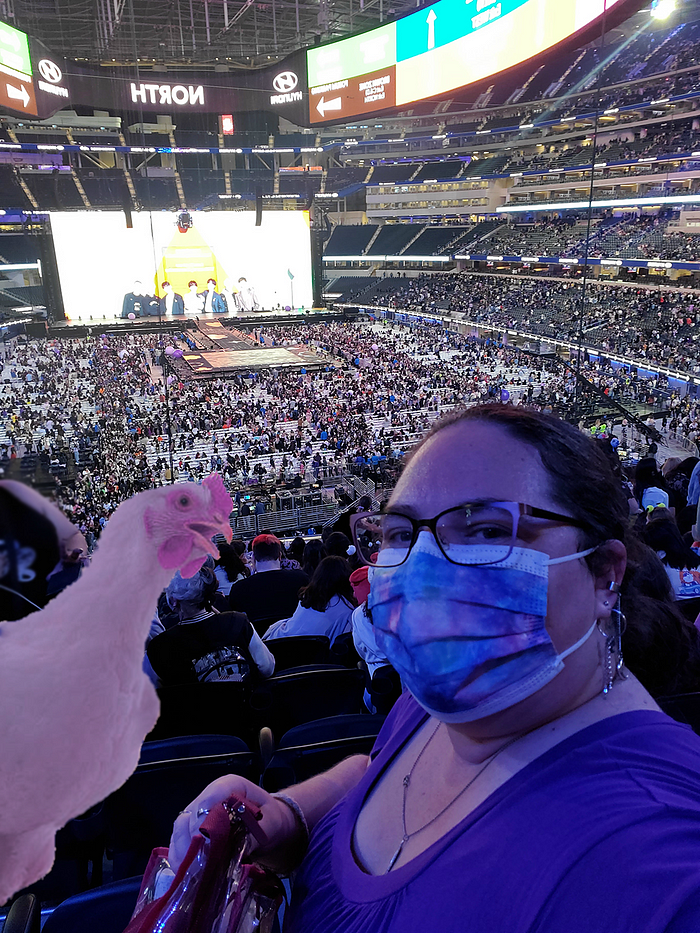
Like the Autcraft community, ARMY are mindful of social justice issues, especially with regard to access. In both communities, we see how play is both a playful activity, but also an important mechanism for more serious endeavors. This might look like an Autcraft member creating a series of YouTube videos of their game play as an anti-bullying campaign. Or this might be a member of ARMY creating a thread of edited BTS content to highlight the international sign the band used in their Permission to Dance video.
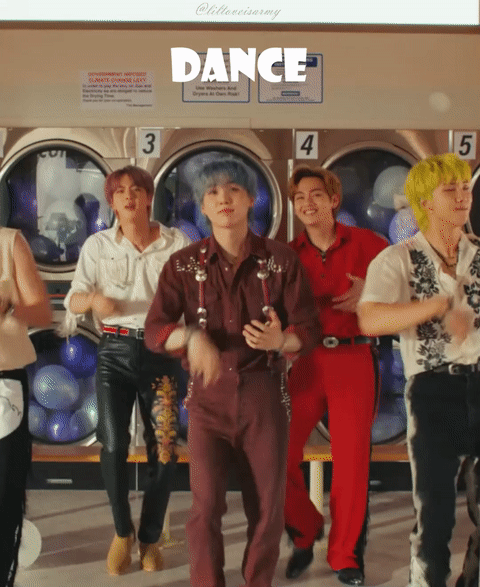
Both communities are also doing the work of correcting misconceptions and pushing back against stigma about themselves. These misconceptions occur because outsiders do not understand the community (often harboring sexism, misogyny, racism, and ableism towards both communities). Particularly, because these are communities of play, they are also often dismissed as ultimately inconsequential by outsiders. This is something both communities would vehemently protest, and do.
Creating Access to Play
Together, these studies show how communities leverage their playful qualities to appropriate and modify the technological and social make-up of the group in order to accommodate a diverse set of community members. From this, we are mostly left with more questions about “play” and “access.” Where is play taking place and can we support ideas of play for the sake of play at the same time play is also being used for more serious business? How is access being created in these various social spaces and what can communities do when they are at the mercy of the technology available to them?
In both communities, we see play being the platform for serious, even life-impacting, interests of community members (e.g., anti-bullying campaigns, grappling with both community-wide and individual trauma). With the advent of the COVID-19 pandemic, these communities became that much more important for its members, as they became the only means of socializing and forming relationships with people outside their homes and places of work. These playful communities were not just a place of leisure or a creative outlet. They are also a place to form meaningful connections with other people.
At the same time, these playful communities are addressing various questions of access. In this talk, I started to illuminate some of the ways communities accommodate disabled community members. The work these communities are doing should be noted because how communities play and what that play is doing for members of communities can be a starting point for understanding these otherwise marginalized groups.
And you can watch a pre-recorded version of the presentation here:
References
1. @bock_twt. 2020. Bantam Seoyeondon: BTS ARMY Shenanigans. In 2020 Rhizome Connect Virtual Conference and Convention. Retrieved September 5, 2021 from https://rhizomeconnect.com/2020/expo-hall/shenanigans/
2. So Yeon Park, Nicole Santero, Blair Kaneshiro, and Jin Ha Lee. 2021. Armed in ARMY: A Case Study of How BTS Fans Successfully Collaborated to #MatchAMillion for Black Lives Matter. CHI 2021: 14.
3. Kathryn E. Ringland. 2019. A Place to Play: The (Dis)Abled Embodied Experience for Autistic Children in Online Spaces. In Proceedings of the 2019 CHI Conference on Human Factors in Computing Systems, 1–14. https://doi.org/10.1145/3290605.3300518
4. Kathryn E. Ringland, Arpita Bhattacharya, Kevin Weatherwax, Tessa Eagle, and Christine T. Wolf. 2022. ARMY’s Magic Shop: Understanding the Collaborative Construction of Playful Places in Online Communities. In Proceedings of the 2022 CHI Conference on Human Factors in Computing Systems.
5. Kathryn E. Ringland, Christine T. Wolf, Heather Faucett, Lynn Dombrowski, and Gillian R. Hayes. 2016. “Will I always be not social?”: Re-Conceptualizing Sociality in the Context of a Minecraft Community for Autism. In CHI 2016.
6. Tanya Titchkosky. 2011. The Question of Access: Disability, Space, Meaning. University of Toronto Press, Toronto, Ontario, Canada.
Just over a week ago, I pulled out of a conference that I was meant to be presenting at this week. So, instead of having a jam-packed week full of presentations and research, I spent the time reflecting (and taking some extremely needed downtime). Now that I’ve taken that time, I wanted to reiterate my commitment to my community in my community-based research.
To be clear: My community in this discussion is BTS and ARMY. I can get a lot more detailed on what that means, but suffice to say this means the people in online and offline spaces who identify as OT7 ARMY. (Happy to talk with you more if you’re curious, just setting the stage for this blog.)
Some of this will be repeating this thread on Twitter and also this thread, but wanted to have one place where this was housed that I (and others) could reference.
Why Me?
I am an academic (I received my PhD in 2018 and now work as a professor) and I study how people use technology in their everyday lives. My expertise is in social platforms and play. What this means is I study games and other social media, but I also keep tabs on other technology.
I research communities and focus on how people interact with one another, how they make and keep relationships, and how the platforms they use help people support each other.
I also have a focus on disability and disability activism. I am myself disabled and use that as a lens to approach all of my work.
I work in communities I care about. I’ve written about this in other threads, but this work takes a lot of time/energy and very careful planning. I wouldn’t do this if I didn’t deeply care about this community.
As a disabled, neurodivergent scholar, I am very very aware of what it means to be othered and marginalized. With that experience, I try to bring compassion & understanding to everything that I do.
Why Research ARMY?
I have several reasons.
ARMY is amazing and the amount of work that happens in this community has already been noticed by outsiders. I hope to highlight some of this, as well as finding out how we can design technological platforms to better support ARMY activities.
I study play and care, which are both things that ARMY excel at. I want to help other people see and understand that about our community.
People are already researching ARMY, whether members of ARMY like it or not. I would love it if the people doing the research were actually ARMY, so they could better contextualize their findings. Worse are the people (who we’ve mostly seen in the form of journalists, but some researchers as well) who have a bias against ARMY and seek to prove it through their research. I do research to give a different perspective.
People are dismissive or ARMY. We know this. By having published research, I hope that we can have concrete things to point people to when they are like this. I have found with other groups I have done research with, that having the published research is a way to showing legitimacy in the face of critics.
What Now?
I am currently conducting my research in my day-to-day life as an ARMY. What does this mean? I spend a lot of time observing what goes on around me and reflecting on it. I write a lot. Most of my writing goes unread by everyone except me. However, eventually some of my writing ends up in blogs like this one or articles that get reviewed by other researchers.
In fact, I have a survey open right now for ARMY to take. I am hoping to combine survey results with my own ethnographic work to improve the reach of my research and to help me triangulate some of my findings.
Survey is here: https://tinyurl.com/BangtanSurvey
I am also extremely committed to making sure ARMY also have all the interesting findings from my work. There are actually lots of things I’m learning and seeing that the research community doesn’t even care about (their loss). So I’m releasing those as I have time to put them together. Here’s an example video I made last week during my downtime.
How Do I Ensure ARMY Isn’t Harmed?
I have taken many precautions in my work to make sure that ARMY and BTS are not harmed to the best of my ability. I’m human and I am sure there will be times this isn’t perfect. However, I still do my best. I’m going to end this article by listing some of the things I have done or plan on doing in this regard.
- Transparency. Wherever possible I am transparent about what I am doing and how I am doing it.
- Care with who I am sharing any data and what they actually have access to. When it comes to tweets, for example, I do not have any direct quotes from ARMY in my published work. I do not include usernames unless I’ve been given very explicit permission (this has only happened once, for a very specific reason, and I didn’t user the full username).
- Making sure the community (and in this case BTS) are discussed respectfully and within community norms. (Yes, I have had to fight on this and I will continue pushing back.)
- Ensuring the places I am presenting about ARMY are safe for ARMY. This means pulling out of conferences and publications if I need to.
- Making sure there is enough context and historical background when discussing anything about communities.
This blog will be a living document that I will come back to as needed in order to update as I work. I’m constantly iterating on my process and love learning from my community!
More about my research here: https://kateringland.com/btsarmy
Human-computer interaction (HCI) is a rather broad, interdisciplinary field. I, myself, am in a unique postdoc where I get to work with and co-train behavioral scientists while doing research into how we can design technology to support people with mental health concerns.
The (Dis)Abled Embodied Experience for Autistic Children in Online Spaces
Preview: Play is an important part of childhood that is often inaccessible for children with disabilities. This work looks at how Autcraft, an online community for autistic children, uses different social media and games platforms to enable access to social play. First, the spaces the Autcraft community uses make the place that is Autcraft possible. Second, these spaces, though some of them are digital, are no more or less “real” than the physical spaces making up a schoolyard or playground.
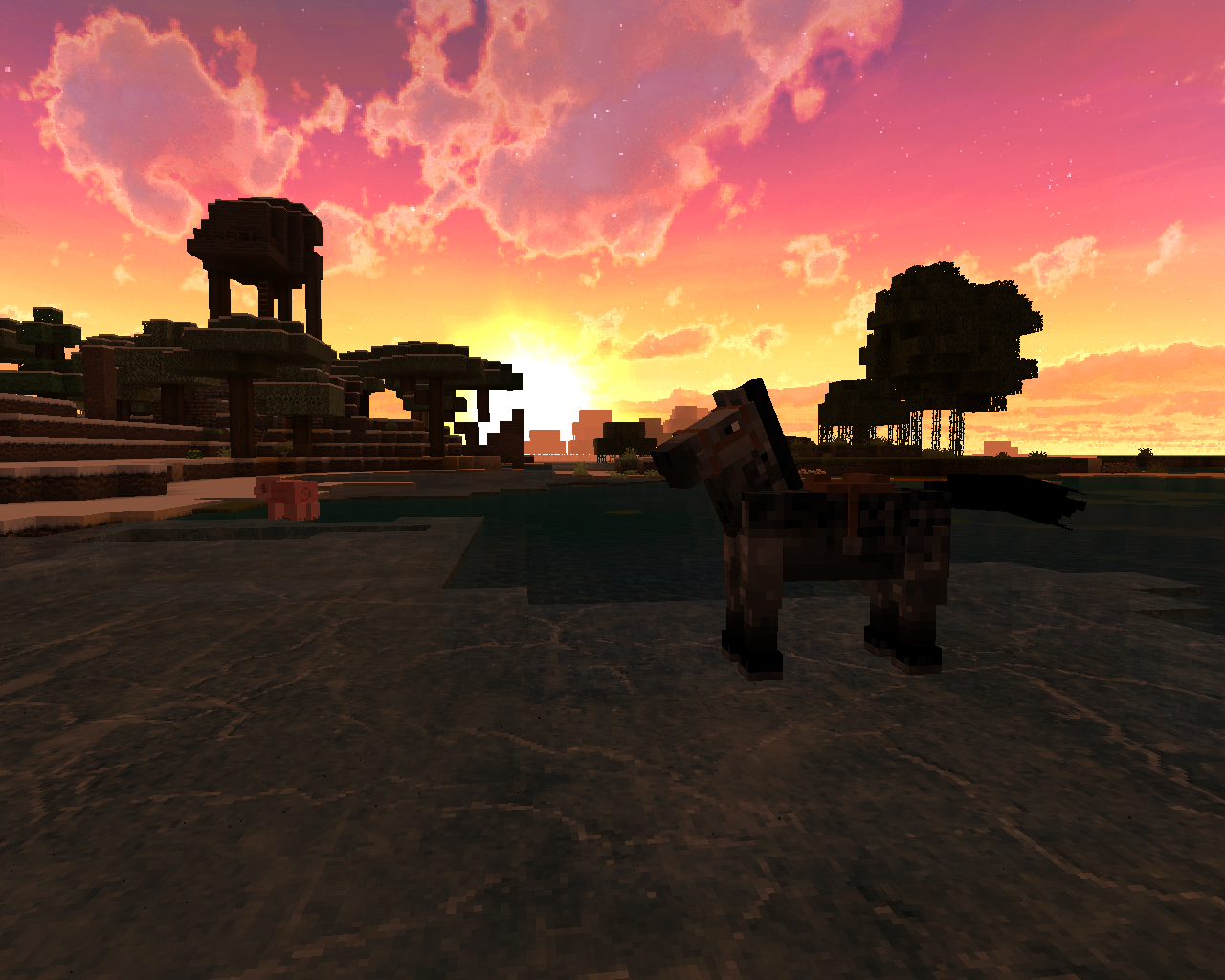
Importance of Play
Social play is an important part of childhood. It is how children develop and practice their social skills. Children engage in a wide range of playful practice roles and test the boundaries of social rules. These playful interactions are vital not only for children to grow into competent, functioning adults, but also to discover who they are and what kind of adults they want to become.
Disabilities and Access to Play
Disability is created when a person is trying to interact with the world and are not accommodated by their environment. An example of this would be a child who wants to play on a playground, but they cannot roll their wheelchair into the space. Access and disability are inextricably linked. Access, in general, is not a given experience for any single individual. Disability is created in the moment that access is faulty or denied to a person. What this means is that disability is not created within a person.
Because a person’s body and their environment are constantly changing, disability is not happening all the time, but rather, a person is disabled by the context with which they are trying to engage. As disability scholar Tanya Titchkosky states, “While we all have bodies — bodies that we act, sense, feel, or move in and through — only some bodies, only some of the time and only in some places, are understood as disabled ones.” Access, therefore, is dynamic and ever shifting.
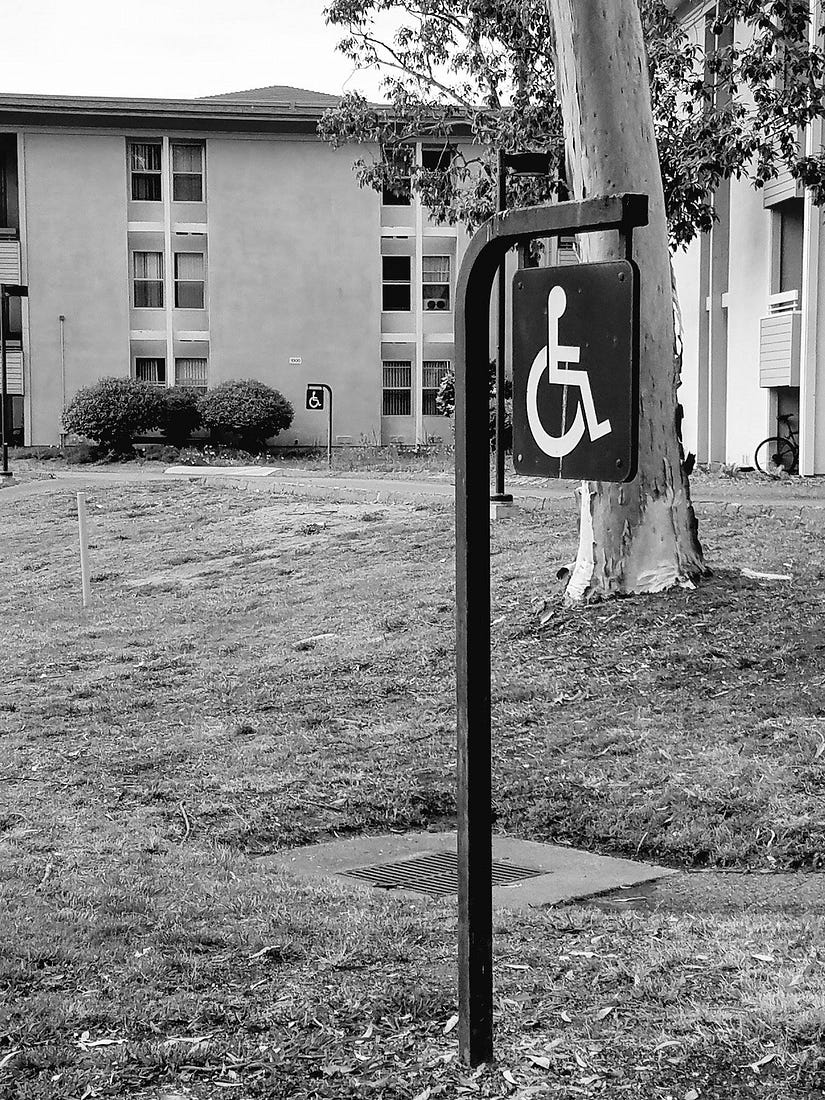
For children with disabilities, including autistic children, access to play is often limited or of low quality. One way to help autistic children gain access to play and socialization is through online spaces, such as social media, games, and virtual worlds. This paper extends previous work in this area, by exploring the disabled experience and how that affects access to play.
Access is really only noticeable when it is not available and creates disability. The disabled body becomes the oppressed body, when they are denied access (advertently or inadvertently), not only in a social sense, but also in a literal, physical sense. Children who do not conform to “normal” and “normal play,” then, are not invited to the game. This is done both literally and through the making play objects that a disabled child cannot use.
Among other activities, individuals with disabilities use online spaces to socialize — empowering themselves to do what they may not be able to in the physical world. Online spaces have different ways of creating access from physical spaces. In this ethnographic work, I explore how one community uses the sense of place and the digital experience in Minecraft specifically to give autistic children access to play with their peers. In this sense, they are using Minecraft to mediate their play experience, just like a physical world playground mediates another kind of play experience. One type of mediated experience is not better (or less mediated) than another. Rather, these experiences, from face-to-face to text to avatars on a computer screen, are diverse kinds of experiences. Simply put, playing in Minecraft with friends is still social play, even though it might look different from playing in a physical playground.
For this work, I studied Autcraft. Autcraft is a Minecraft community for children with autism and their allies run by parent volunteers. The goal of the Autcraft community is to have a safe space for children with autism to play Minecraft free from harassment and bullying (for more information visit the Autcraft website). As part of this study, I have been conducting an on-going ethnography within the community (see my paper for details). This study included analysis of activity within the Minecraft server, forums, website, Twitter, Facebook group, YouTube, and Twitch.
The Different “Spaces” of Autcraft
In this work, I found the Autcraft community actively creates access to social play using a variety of social media and other technology. By looking at the entire constellation of social media in the Autcraft ecosystem, we can understand how community members are engaging in a variety of social play experiences.
Access to the Autcraft community happens through three layers of interconnected environments: physical, liminal, and virtual. The physical space includes computer hardware and the environment in which players access the computer. This would be things like a bedroom, home office, or computer lab in the library. The liminal space includes the installation and configuration of the software, as well as user authentication. Finally, the virtual space includes the various social media.
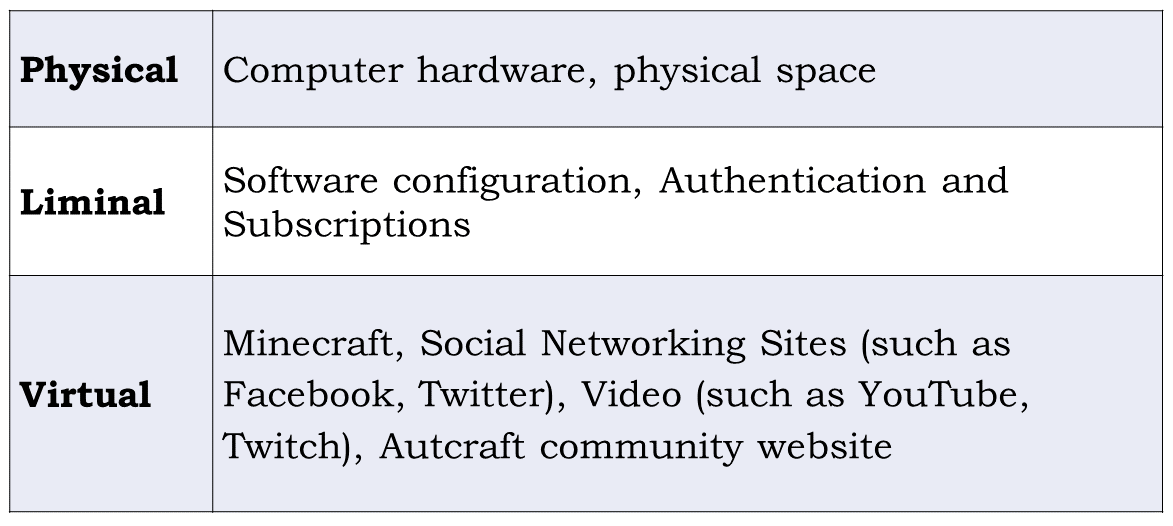
When combined, these spaces allow play to happen because the children have access to play in a context in which they “fit.” When educators, therapists, parents, and researchers privilege face-to-face interactions, they are, in effect, creating disability in children who cannot or will not play in that way. In the Autcraft community, members can recreate the playground in an environment that is more comfortable for them. Community members leverage technology to create a playground where children are most able to play. And, having done this, autistic children engage in social play of which people thought them incapable.
The Autcraft community has used a constellation of platforms to enable social play for autistic children. Here the Autcraft community is using the constellation of technological platforms to help create the sense of place. These platforms cross into physical, liminal, and virtual spaces, working together to create access to play. Here the Autcraft community have leveraged virtual worlds to their advantage — in essence, transforming the disabled play experience into an enabled one.
How someone interacts with others is meaningful, regardless whether that interaction is online or offline. For the autistic children of Autcraft, playing in online spaces is preferable to physical-world, face-to-face interactions. The Autcraft community has defied the conventions set out by many educators, parents, researchers, and therapists by creating a space that privileges digital engagements over physical-world ones. In doing so, they have made a playground that is more comfortable for many autistic children.
Children need a place to play. There are two things to consider: creating a sense of place and allowing for both the real and unreal in these places. Therapists, educators, parents, and researchers tend to privilege the physical realm over all others for mediating sociality. Members of the Autcraft community turn this notion on its head, instead privileging virtual interactions over physical ones. But further still, I have shown how all these spaces — physical, liminal, and virtual — must work together to make play possible. The spaces the Autcraft community uses make the place that is Autcraft possible. These spaces, though some of them are digital, are no more or less “real” than the physical spaces making up a schoolyard or playground. Ultimately, it the sense of place in Autcraft that gives children access to social play.
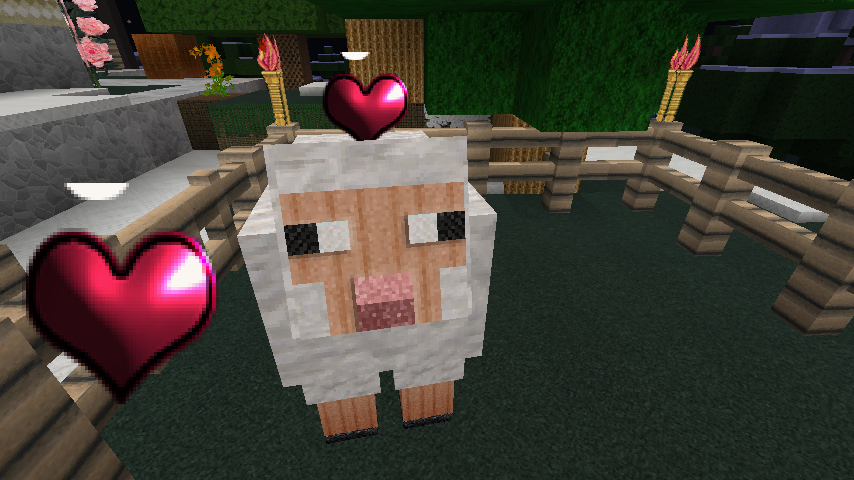
For more details about my methods and findings, please see my paper that has been accepted to CHI 2019 (to appear in May 2019). I am pleased to announce that this has received Honorable Mention (top 20% of all papers) Full citation and link to the pdf:
Kathryn E. Ringland. 2019. A Place to Play: The (Dis)Abled Embodied Experience for Autistic Children in Online Spaces. In CHI 2019. [PDF]
Acknowledgements
I thank the members of Autcraft for the warm welcome to their community. Thank you to Chris Wolf, LouAnne Boyd, and Oliver Haimson and other members of LUCI for their feedback on various iterations of this work. Special thanks to Severn Ringland for his diligent editing and Kyle Lee for insights while writing this up. Shout out to my dissertation committee who helped me shape my thoughts: Gillian Hayes, Tom Boellstorff, Mimi Ito, and Aaron Trammell. I would also like to thank Robert and Barbara Kleist for their support, as well as the ARCS Foundation. This work is supported by the National Institute of Mental Health (T32MH115882). The content is solely the responsibility of the authors and does not necessarily represent the official views of the NIH. This work is covered by human subjects protocol #2014–1079 at the University of California, Irvine.
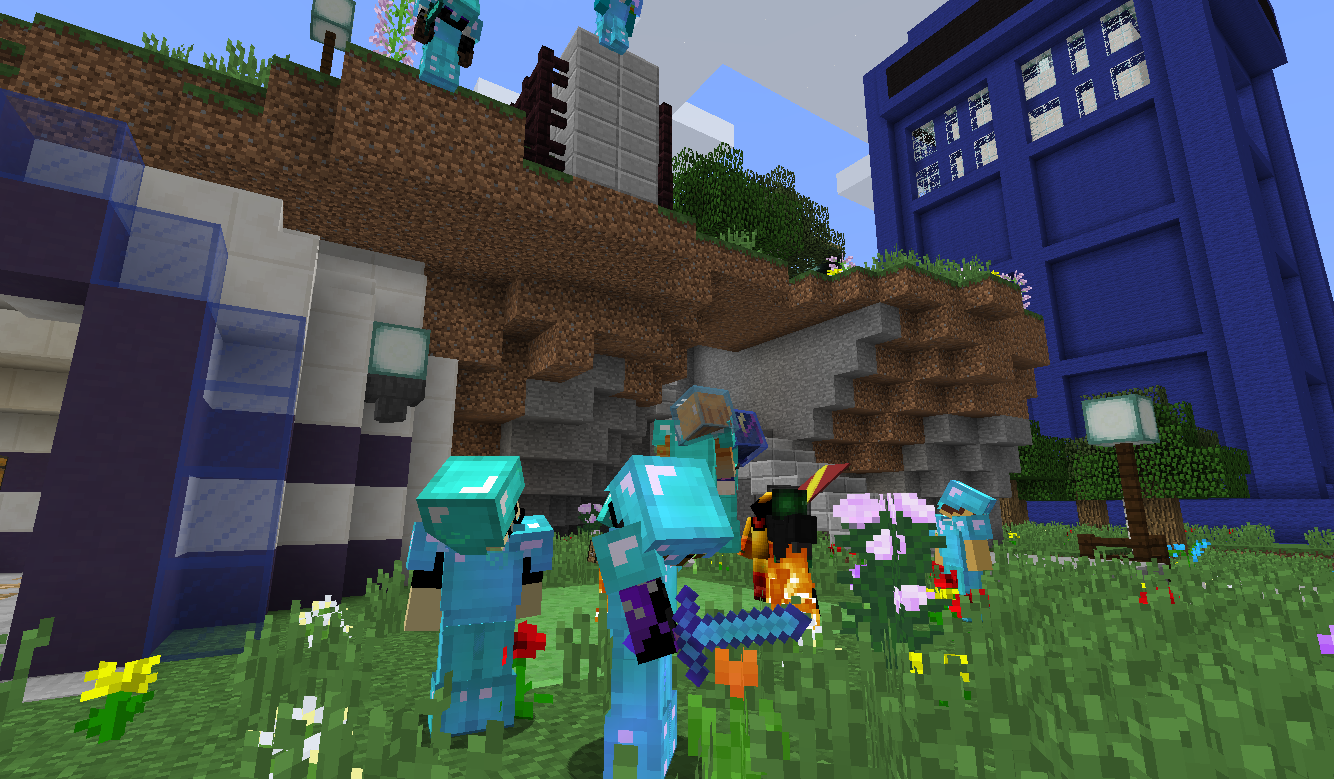
Preview: Autism is a medical diagnosis that has attracted much attention in recent decades, particularly due to an increase in the numbers of children being diagnosed and the changing requirements for getting the diagnosis. In parallel online communities around autism—both those supporting individuals, families seeking treatment and those supporting embracing the autism identity—have grown. Other work has shown support groups can be useful for those encountering hardship in their lives. In this paper, I illuminate the tension in claiming the autistic identity within this community. The walls of the community work to keep community members safe, but also set them apart from others on the internet. I see that the Autcraft community goes beyond being a support group for victims of targeted violence, to one that redefines and helps community members embrace their own autistic identities.
What is autism and what impact does the label of autism have?
Autism has been the topic of much public concern in recent decades, especially since the sensationalized “autism epidemic” swept through the media. As a medical diagnosis, autism focuses on challenges for individuals; such as whether they are verbal, make eye-contact, or are sensitive to change. Often, as a label, autism is given to youth in order to gain accommodations in school, or for medical treatment. Autistic youth often experience various ways in which this label is used to disempower and disenfranchise them.
This is the case for many youth that are a part of an online community, “Autcraft,” a community centered on a Minecraft virtual world for autistic youth. While those with autism are often the target of harassment and violence in online spaces, the Autcraft community has been actively engaged in making themselves a safe space for youth with autism. Beyond simply keeping bullies out, however, the community has taken the label of “autism” and turned it into something positive—a label worth identifying with.
In the Autcraft community, I have found that the label acts both as a target and as a way for community members to redefine their identities.
Targeting Autism
Concerns over safety of children is an ongoing concern for parents and other caregivers. This is particularly true of those with autistic children, as those with autism tend to be targeted both by their peers and by strangers [32]. Much like other marginalized groups, “autism” is used as a derogatory term. Further, threats of violence can be found across the internet, including in the comments section of YouTube videos, a site used by Autcraft community members. This is especially meaningful as other related work has shown the embodied experience in these online spaces can be as impactful as in physical spaces [29]. Unfortunately, these threats of violence can also result in actual physical harm.
Harassment, threats of violence, and comments about autistic people killing themselves can have a large impact on those targeted, such as additional stress and other psychological harm [22]. The harm, however, does not stop with verbal and written threats. Like other marginalized communities, those with autism face the very real threat of violence against them [14,15].
Here is a video related to these threats of violence in the autistic community at large.
Redefining Autism
There is evidence throughout the
Autcraft community of those who are expressing their autistic identity. Autcraft
community members may be learning to understand and accept themselves or their
child as an autistic individual, but they are also learning to deal with
challenges found outside the Autcraft community where they may not find
themselves accepted and face opposition.
[alt-text for embedded tweet picture: autsome, adjective, Having autism and being extremely impressive or daunting; inspiring great admiration. “My autsome child makes me proud everyday!” synonyms: breathtaking, awe-inspiring, magnificent, wonderful, amazing, stunning, staggering, imposing, stirring, impressive; informal extremely good; excellent. “The band is truly autsome!”]
Adopting “autism” and various forms of the word—as seen in the name of the community “Autcraft”—lends to a sense of identity with others who have the same or similar medical diagnosis. Aside from using “aut” or “autistic” in their user names (i.e., the names that are displayed with their avatars and forum posts, rather than a real-world name), the Autcraft community displays this acceptance through the creation of autism-centric words, such as “autsome.” According to a community post, “autsome” means, “Having autism and being extremely impressive or daunting” and “extremely good; excellent.” Scholars have described how those with disability are often held to a higher standard and those who are “extreme” tend to be held up as inspirational. This type of “inspiration” frames disability as something to be overcome, while achieving difficult objectives. However, I argue that having language such as “autsome” is meant to be inspirational not for others looking in to the Autcraft community, but for the autistic children who are otherwise dealing with a barrage of negative language about autism. This reframes autism as an identity that is worth embracing, rather than overcoming.
Autcraft community members actively work to reshape the mainstream dialog about autism. First and foremost, members try to lead by example, following a set of tenets set out by community founders that encourage and promote good behavior. Community members also engage in outreach to both educate others and to make their own expressions of their autistic identities more visible to others. Members of the Autcraft community engage in activities—much like creating memorials for victims of violence—that purposefully shed light on the hardships they have faced. These efforts are examples of how those with marginalized identities fight back against oppression. As scholars, by listening to these community members and understanding their activities, we can begin to elevate the voices of those who have long been silenced.
For more details about our methods and findings, please see my paper that has been accepted to iConference 2019 (to appear in April 2019). Full citation and link to the pdf below:
Kathryn E. Ringland. 2019. “Autsome”: Fostering an Autistic Identity in an Online Minecraft Community for Youth with Autism. In iConference 2019 Proceedings. [PDF]
Acknowledgements: I thank the members of Autcraft for the warm welcome to their community. Thank you to members of LUCI for their feedback and special thanks to Severn Ringland for his diligent editing. I would also like to thank Robert and Barbara Kleist for their support, as well as the ARCS Foundation. This work is covered by human subjects protocol #2014-1079 at the University of California, Irvine. This work is supported by the National Institute of Mental Health (T32MH115882). The content is solely the responsibility of the authors and does not necessarily represent the official views of the NIH.
How to handle multiple authors, get a your paper written, and not drive everyone crazy
For those just starting out in the paper writing process: Welcome! It’s an exciting journey! In the field of HCI, having multiple coauthors is normal. So, in the spirit of helping everyone out, here is a handy guide to help manage the project of getting a paper written when there are multiple coauthors. (And honestly, some of this is probably good if you’re solo on a paper, too.)
A PDF version of this guide is available here.
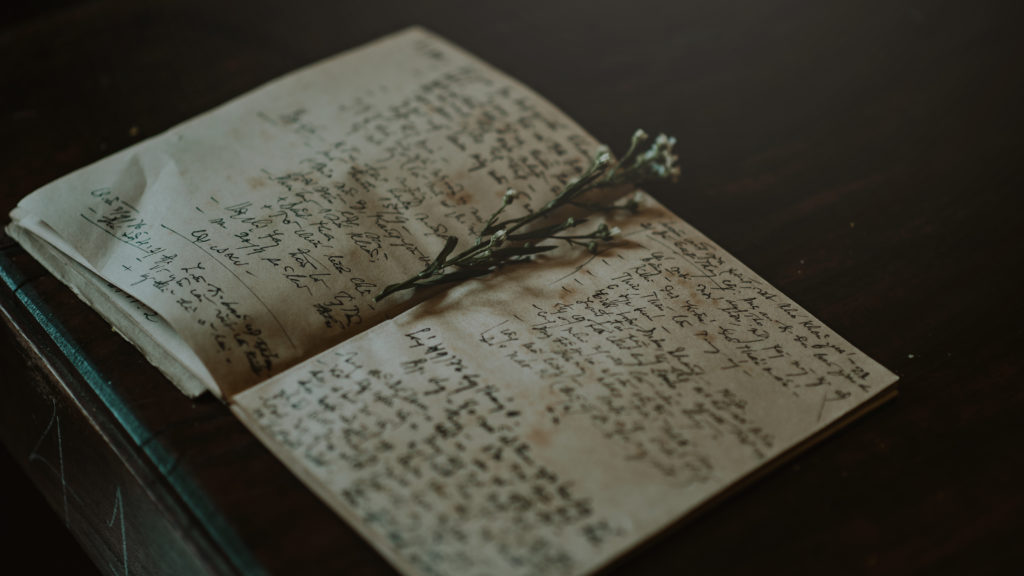
Step 1. Establish norms among the authors.
- Versioning: how will you handle multiple versions of the paper? Where will they be stored? Who will have access to them? What software will you be using?
- Along with versioning, set clear norms around document names and stay consistent for the entire lifecycle of the paper.
- Authorship: clearly identify tentative author order,
explain community norms to outside authors, establish expectations of %
contribution
- This also means establishing when various authors on the team will be involved. Some may come in at the end to shape the discussion while others might help with literature review. This should be decided upon now to avoid surprises down the road.
- Set deadlines. Be flexible. Know that everything will probably take 3x longer than you expect.
Step 2. Early-stage Drafts.
- Adhere to versioning established in step 1.
- Co-writing or tandem writing is fine for early stages of writing. This includes splitting up the sections between different authors. Be sure everyone is aware of what everyone else is doing to avoid doubling up on the work.
- When making big conceptual decisions about the paper, consult all of the authors involved for feedback.
Step 3. Later-stage Drafts.
- After some agreed-upon time (as most sections are filled in, for
example), move to writing in sequence, rather than parallel. This helps avoid
having a choppy sounding paper and makes sure things like the overarching
thread is pulled throughout the paper.
- This means someone will have the “lock” on the paper. Establish norms around how this is specified and handled. This can be a simple “I have the lock” to the group via email (or slack), meaning no one else should be working on the draft. Or using file names in the shared folder to indicate when a draft is “in progress” or “done.”
Step 4. Final Draft & Submission.
- Congrats on getting to a final draft! Be sure all authors have signed off on the final version before submitting.
- Be sure to send the final version after submission for everyone’s records.
Step 5. Revisions & Camera Ready.
- Co-authors are great for sharing the joy of an acceptance or commiserating over a rejection. Be sure to be clear about who will be helping with revisions if needed.
- If a paper is being resubmitted to another venue, this entire process starts over again. Good luck!
*Other Thoughts*:
- Clear, frequent communication is key. Ghosting your co-authors isn’t cool.
- This process is hard and everything I mentioned above are skills. That means the only way to get better is through practice.

What other things are important to remember about the writing process? Leave a comment below!
Our new article is out in First Person Scholar! Amanda Cullen, Chris Wolf, and I write about disability representation in Overwatch and the future of representing disability in games more broadly.
Check it out here: http://www.firstpersonscholar.com/a-better-world/

In exciting news, Stuart Duncan’s TEDx Talk, How I used Minecraft to help kids with autism, is now featured on the ted.com front page! Check it out (and spot our research being highlighted)!!
